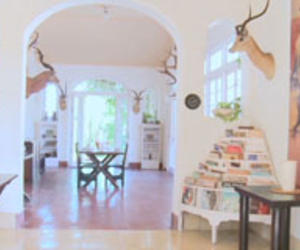Literature grad writes thesis on Hemingway, Cuba
- Submitted by: manso
- Arts and Culture
- 05 / 07 / 2011

May 06, 2011. Is there anything left to write about Ernest Hemingway and his stories? One would think that the noted American author has been thoroughly covered, but according to ASU graduate student Sarah Driscoll, there’s still more to learn. And more to say.
Driscoll, who will receive her master’s degree in American literature May 12, wrote her thesis on Hemingway’s relationship to the people of Cuba, and to Cuban artist Antonio Gattorno, whom Hemingway met in Havana in the late 1920s or early ‘30s.
“My thesis may be uncharted territory,” said Driscoll. “Little has been done on Hemingway’s Cuban life. I started with the question of what Hemingway’s life in Cuba was like and what relationship he developed with the Cubans.”
Driscoll, who has long been interested in all of the Americas, received a Corrigan Fellowship from the Hemingway Society in 2009, and went to the J.F.K. Library in Boston – her home territory – for a quick trip through the library’s Hemingway archives.
“I only had $1,000 to spend, and three weeks. I hoped to find out something right away,” Driscoll said.
After perusing many of the letters in the Hemingway files, Driscoll became fascinated with the writer’s friendship with Gattorno, an avant-garde and primitivist painter.
“My thesis shows that Hemingway influenced Gattorno’s imagination of himself as a global painter, and Gattorno’s eventual departure from Cuba,” Driscoll said.
“Hemingway wrote the introduction to Gattorno’s first monograph, and he was Gattorno’s patron, mentor, encourager, almost father figure and promoter of America.” (Gatterno and his wife lived in New York City for more than 30 years.)
Before piecing together the stories revealed by Hemingway’s letters, Driscoll had to first translate them from “Hemingway’s Spanish into regular Spanish,” she said. (Fortunately, Driscoll, who is married to a native Costa Rican, is fluent in Spanish.)
The letters revealed that Hemingway and Gatterno were complementary personalities, and that there was great affection between them.
“The letters also showed that Hemingway was not doing well as a novelist in the 1930s, and his answer was to invest himself in the art world. He purchased a great many paintings in the 1930s,” Driscoll said.
In her thesis, Driscoll also writes about how Hemingway has reinforced the link between Cuba and the United States, two countries that she says have been “intrinsically connected to each other forever.”
Driscoll’s next goal is to visit Hemingway’s house just outside Havana, which is a landmark 1887 structure built in the Old Spanish style. “In the house in Cuba, which is not open to the public, there are more than 3,000 Hemingway documents that haven’t been looked at,” she said. “But since 2002 we’ve had the beginnings of opening scholarship. I’m hoping to go to Cuba this summer.”
Driscoll, who currently teaches American literature at Phoenix Country Day School, plans to study for a doctorate after she completes her master’s degree, and to broaden the way she approaches American literature.
Inspired by Hemingway, and by her experiences as a teacher in Costa Rica, and her love for the Hispanic culture, she concentrate on comparative literature, exploring the riches of all American writers.
“Hemingway has united Cubans across time, and the Americas,” she said. “For Hemingway, the Americas transcended boundaries.”
With the help of her advisers in the Department of English, Claudia Sadowski-Smith and Elizabeth Horan, Driscoll has already published two reviews in leading academic journals, and she plans to expand her Cuba-Hemingway research into a book.
Overachieving is nothing new to Driscoll. While teaching full time – with the full support of Phoenix Country Day School – going to graduate school at ASU, and taking care of her family, she’s managed to maintain a grade-point-average of 4.0.
Contributed by Judith Smith
Source: http://asunews.asu.edu/20110506_commencement_driscoll
Comments